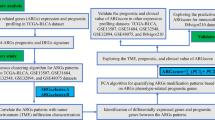Abstract
The TUNEL reaction was used to study induced apoptosis in the tumor cells of urinary bladder cancer (UBC) patients. It has been shown that an increase in the values of induced apoptosis correlates well with the indicators showing a tumor’s corresponding response to the application of neoadjuvant chemotherapy, using the gemcitabine-cisplatin regimen. It has been concluded that assessing the level of induced apoptosis in UBC tumor cells using the TUNEL assay enables making a prognosis for the efficacy of chemotherapy at the single-cell level in patients with this type of cancer.
Similar content being viewed by others
References
Abramenko, I.V. and Fil’chenkov, A.A., Prognostic Significance of Apoptotic and Proliferative Indices in Solid Tumors, Onkologiya, 2002, vol. 4, no. 3, pp. 165–170.
Zav’yalova, E.S., Clinical and Morphological Criteria for Predicting the Clinical Course of Transitional Cell Bladder Cancer, Extended Abstract of Cand. Sci. (Med.) Dissertation, St. Petersburg, 2010.
Zlokachestvennye novoobrazovaniya v Rossii i stranakh SNG v 2002 godu (Malignant neoplasms in Russia and CIS in 2002), Davydov, M.I and Aksel’, E.M., Eds., Moscow: Med. Inform. Ag., 2004.
Kaprin, A.D., Modern Concepts of Treatment of Bladder Cancer, Lechashchii Vrach, 1999, no. 4, pp. 54–58.
Fil’chenkov, A.A. and Stoika, R.S, Apoptoz i rak (Apoptosis and Cancer), Kyiv: Morion, 1999.
Cancer in Ukraine in 2007–2008: Morbidity, Mortality, and Oncological Service Data, Shchepotin, I.B., Ed., Bull. Ukr. Natl. Cancer Register, 2009, no. 10.
Bachmann, I.M., Ladstein, R.G., Straume, O., Naumov, G.N., and Akslen, L.A., Tumor Necrosis Is Associated with Increased AlphavBeta3 Integrin Expression and Poor Prognosis in Nodular Cutaneous Melanomas, BMC Cancer, 2008, vol. 5, no. 8, p. 362 (doi: 10.1186/1471-2407-8-362).
Calabró, F., Lorusso, V., Rosati, G., Manzione, L., Frassineti, L., Sava, T., Di Paula, E.D., Alonso, S., and Sternberg, C.N., Gemcitabine and Paclitaxel Every 2 Weeks in Patients with Previously Untreated Urothelial Carcinoma, Cancer, 2009, vol. 115, no. 12, pp. 2652–2659.
Cordon-Cardo, C., Mutation of Cell Gene Regulators. Biological and Clinical Implications for Human Neoplasia, Amer. J. Pathol., 2005, vol. 47, pp. 545–560.
Dubska, L., Matalova, E., and Misek, I., Detection of Apoptosis in Paraffin Embedded Tissues: the Influence of Tissue Type and Fixation, Acta Vet. Brno, 2002, no. 71, pp. 529–533.
Dumez, H., Martens, M., Selleslach, J., Guetens, G., De Boeck, G., Aerts, R., De Bruijn, E.A., Maes, R.A., and van Oosterom, A.T., Docetaxel and Gemcitabine Combination Therapy in Advanced Transitional Cell Carcinoma of the Urothelium: Results of a Phase II and Pharmacologic Study, Anticancer Drags, 2007, vol. 18, no. 2, pp. 211–218.
Von der Maase, H., Gemcitabine in Transitional Cell Carcinoma of the Urothelium, Exp. Rev. Anticancer Ther., 2003, vol. 3, no. 1, pp. 11–19.
Kamat, A.M., Karashima, T., Davis, D.W., Lashinger, L., Bar-Eli, M., Millikan, R., Shen, Y., Dinney, C.P., and McConkey, D.J., The Proteasome Inhibitor Bortezomib Synergizes with Gemcitabine to Block the Growth of Human 253JB-V Bladder Tumors in vivo, Mol. Cancer Ther., 2004, no. 3, pp. 279–290.
Khaled, H.M., Zaghoul, M.S., Ghoneim, M., et al., Gemcitabine and Cisplatin as Neoadjuvant Chemotherapy for Invasive Bladder Cancer: Effect on Bladder Preservation and Survival, Proc. Amer. Soc. Clin. Oncol., 2003, no. 22, p. 411.
Lawry, J., Detection of Apoptosis by the TUNEL Assay, Cancer Cell Culture, 2004, vol. 88, pp. 183–190.
Mizutani, Y., Nakao, M., Ogawa, O., and Yoshida, O., Bonavida B., Miki T., Enhanced Sensitivity of Bladder Cancer Cells to Tumor Necrosis Factor Related Apoptosis Inducing Ligand Mediated Apoptosis by Cisplatin and Carboplatin, J. Urol., 2001, vol. 165, no. 1, pp. 263–270.
Author information
Authors and Affiliations
Corresponding author
Additional information
Original Russian Text © O.I. Iatsyna, E.O. Stakhovsky, Ya.A. Sheremet, S.I. Spivak, O.E. Stakhovsky, O.N. Gavrilyuk, Yu.V. Vitruk, A.I. Emets, Ya.B. Blyum, S.V. Vernygorodskyi, 2011, published in Tsitologiya i Genetika, 2011, Vol. 45, no. 4, pp. 3–8.
About this article
Cite this article
Iatsyna, O.I., Stakhovsky, E.O., Sheremet, Y.A. et al. Specific features of the apoptotic response of urinary bladder cancer cells to neoadjuvant chemotherapy. Cytol. Genet. 45, 201–207 (2011). https://doi.org/10.3103/S0095452711040128
Received:
Published:
Issue Date:
DOI: https://doi.org/10.3103/S0095452711040128




